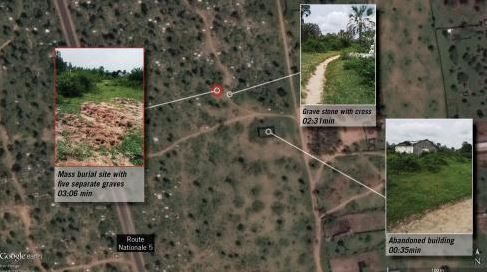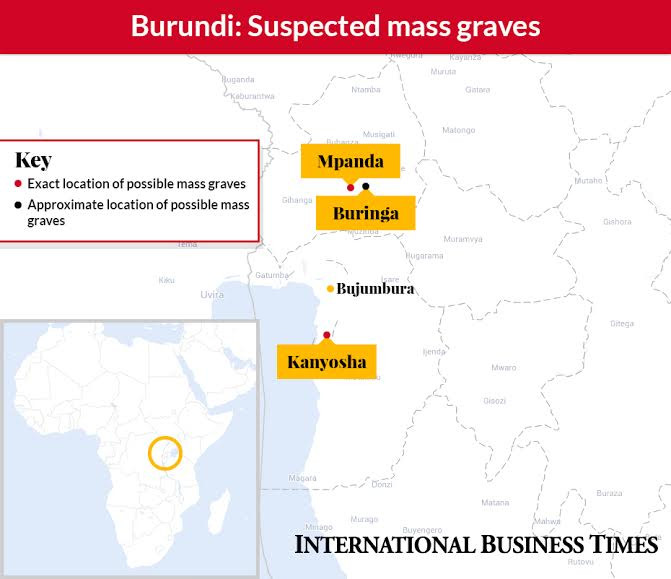Burundi: Five questions to Amnesty International about possible mass graves in Bujumbura
Rights group Amnesty International claimed it has found five possible mass graves near Burundi's capital, Bujumbura, where security forces were accused of killing dozens of people in December.
The findings come days before African leaders are due to meet at the African Union (AU) summit in Addis Ababa to discuss the conflict in Burundi where between 800 and 900 people are reported to have been killed since April 2015 after President Pierre Nkurunziza announced a controversial decision to run for a third term, which he won in contested elections in July 2015.
Scores of bodies are reportedly still being found in the streets or in ditches, and dozens of civilians have simply disappeared, in tit-for-tat violence pitting pro-Nkurunziza forces against insurgents – leading analysts to warn of an impending civil war amid claims of mass executions.
11 December killings
Burundian forces – including the police – killed dozens of people that day after a pre-dawn rebel attack on three military installations in Bujumbura. During raids on so-called dissenting neighbourhoods (Musaga, Nyakabiga, Mutakura, Cibitoke, Ngagara and Jabe), the forces entered houses, forcibly took men away and shot some at close range.
Following the 11 December attack on army barracks, the death count of which has been set at 87 by the government, and up to 200, according to the UN, one of Amnesty's researchers went to a number of sites where people "were killed at very close range".
"She didn't see any body there, yet there were pools of blood on the ground," Christoph Koettl, a senior analyst at Amnesty International told IBTimes UK on Friday (29 January). Amnesty published findings in December, but Koettl said one open question remained: where did the bodies go? "Our suspicion was that the government tried to cover-up this, by hiding the bodies, because they were not in the city's morgues."
What do the images show?
As reports of mass graves emerged, Amnesty analysed satellite images, and said the evidence is overwhelming. Taken in conjunction with the removal of many of the bodies by security forces before they could be identified, Koettl said this evidence suggests a deliberate cover-up and attempt to prevent proper investigations into the events of 11 December.
Before and after satellite images and video footage "clearly show" five possible mass graves in the Buringa area, on the outskirts of Bujumbura.
"The evidence is not just one satellite image, but it is a bigger peace of research based on two weeks of fact finding in December. This research enables us to make this big case," Koettl said over the phone.
The imagery, dating from late December and early January, shows disturbed earth consistent with witness accounts, which indicated that the graves were dug on the afternoon of 11 December, in the immediate aftermath of the bloodiest day of Burundi's escalating crisis.
The video footage (see video) shows a man walking around in a field and arriving on the actual burial site. It was based on that video that Amnesty was able to pinpoint the exact spot of the graves.
"There is an abandoned building and a telecommunication pole in the video, which enabled us to find the exact location," Koettl explained. Because mapping platform Google Earth's imagery was not up to date – the most recent set of images dated November 2015 – Amnesty bought high resolution images from commercial satellite image provider Digital Globe.

"What the imagery showed was there was an area of around 50sqm of freshly disturbed earth - which wasn't surprising (because of what the video has captured), but the images confirmed the exact size of the site and narrowed down the timeframe."
The team compared images from early November, where the earth is untouched, 22 December – 10 days after the killings allegedly took place when the earth is disturbed, and 7 January 2016, when grass started to grow back. "That tells us this is something new, a very new burial site, which could have only happened between November and 22 December 2015. That matched up perfectly with all the other information we gathered."
Where are the mass graves?
Amnesty confirmed it had received information about the existence of "multiple sites". "We believe that there are more than these three sites,"Koettl said. In addition to the Buringa site, Amnesty received credible reports of suspected mass graves of people killed on 11 December in several other locations, including Mpanda and Kanyosha cemeteries.
"The interesting one about the possible burial site in the city (Kanyosha) is that a French crew was filming there, and once they were there, somebody showed up straight away. They (the crew) left immediately because they felt intimidated," Koettl said. "People are watching, surveilling these sites".

How many bodies are buried in the possible graves?
The images, along with video footage and testimonies, indicate that "dozens of people" killed by Burundian security forces in December may have been later buried in those graves, Koettl said. Local sources told Amnesty that 25 bodies were buried in five graves at the Mpanda site, and 28 bodies were buried in four graves at the Kanyosha site. It is not known how many bodies might be found at other sites.
Are there any witnesses?
Amnesty International researchers were in Bujumbura when the killings occurred and visited affected neighbourhoods, including Nyakabiga, the next morning. Witnesses described how police and local officials scoured Nyakabiga and other neighbourhoods to retrieve the bodies of those who were killed and took them to undisclosed locations.
Residents described how the bodies of at least 21 men were left in the streets, homes and drainage ditches. Researchers found large pools of blood where some of the victims had been killed but the bodies had been removed. The mother of a 15-year-old boy who was allegedly shot in the head as he ran to take refuge in an outhouse in the Musaga neighbourhood, told Amnesty that a pickup truck from the mayor's office retrieved her son's body. The men that took him refused to tell her where the body was being taken. "I don't know where he is or if he's been buried," she said.
Will the possible graves be investigated?
"African leaders gathering at the AU summit must call on the Burundian government to grant international investigators access to all suspected grave sites and launch an immediate, independent and impartial investigation into the killings and why most families were given no opportunity to retrieve and bury their dead," Muthoni Wanyeki, the organisation's regional director for East Africa, the Horn and the Great Lakes, said.
"Families need to know what happened to their loved ones and to be able to bury them in dignity. These suspected grave sites must be secured until proper investigations can be carried out, and any bodies found in them should be exhumed to assess the causes of death."
Koettl told IBTimes UK the United Nations (UN) are currently leading their own satellite image analysis, but the examination concerns nine different burial sites. "We only looked at one site (Buringa), but this is a much larger issue. It will be interesting to see the UN's findings."
This week, a team of independent experts mandated by the UN to probe violations and abuses in Burundi was not able to enter the country.
© Copyright IBTimes 2025. All rights reserved.






















